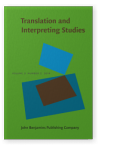Lozano-Argüelles, Cristina, Nuria Sagarra & Joseph V. Casillas
2023.
Interpreting experience and working memory effects on L1 and L2 morphological prediction.
Frontiers in Language Sciences 1

Rybakova, Nataliia V.
2023.
LON GITUDINAL STUDIES OF WORKING MEMORY CAPACITY IN SIMULTANEOUS INTERPRETING STUDENTS.
Lomonosov Journal of Philology :№4, 2023
► pp. 194 ff.

Xu, Renwen, Boya Zhang & Binghan Zheng
Özkan, Deniz, Ena Hodzik & Ebru Diriker
Boos, Michael, Matthias Kobi, Stefan Elmer & Lutz Jäncke
2022.
Tracking lexical access and code switching in multilingual participants with different degrees of simultaneous interpretation expertise.
European Journal of Neuroscience 56:6
► pp. 4869 ff.

Chou, Isabelle, Jiehui Hu, Edinson Muñoz & Adolfo M. García
2021.
Discourse-Level Information Recall in Early and Late Bilinguals: Evidence From Single-Language and Cross-Linguistic Tasks.
Frontiers in Psychology 12

He, Yan, Yinying Hu, Yaxi Yang, Defeng Li & Yi Hu
2021.
Optical Mapping of Brain Activity Underlying Directionality and Its Modulation by Expertise in Mandarin/English Interpreting.
Frontiers in Human Neuroscience 15

He, Yan & Jiayi Wang
2021.
Eye Tracking Uncertainty Management in Sight Translation: Differences Between Professional and Novice Interpreters. In
Advances in Cognitive Translation Studies [
New Frontiers in Translation Studies, ],
► pp. 181 ff.

Liu, Xiaodong
2021.
Cognitive Processing Routes: An Interdisciplinary Perspective. In
Cognitive Processing Routes in Consecutive Interpreting [
New Frontiers in Translation Studies, ],
► pp. 17 ff.

Liu, Xiaodong
2021.
Cognitive Processing Routes in CI: Source Categories and Grammatical Units. In
Cognitive Processing Routes in Consecutive Interpreting [
New Frontiers in Translation Studies, ],
► pp. 97 ff.

Liu, Xiaodong
2024.
Mapping translation process research: A bibliographic study on special issues since year 2005.
Forum for Linguistic Studies 6:2
► pp. 1169 ff.

胡, 敏霞
2021.
The Two-Way Relationship between Interpreting Experience and Working Memory—A Review of Empirical Evidence.
Modern Linguistics 09:01
► pp. 187 ff.

Dottori, Martin, Eugenia Hesse, Micaela Santilli, Martina G. Vilas, Miguel Martorell Caro, Daniel Fraiman, Lucas Sedeño, Agustín Ibáñez & Adolfo M. García
2020.
Task-specific signatures in the expert brain: Differential correlates of translation and reading in professional interpreters.
NeuroImage 209
► pp. 116519 ff.

Ferreira, Aline, John W. Schwieter & Julia Festman
2020.
Cognitive and Neurocognitive Effects From the Unique Bilingual Experiences of Interpreters.
Frontiers in Psychology 11

García, Adolfo M., Edinson Muñoz & Boris Kogan
2020.
Taxing the bilingual mind: Effects of simultaneous interpreting experience on verbal and executive mechanisms.
Bilingualism: Language and Cognition 23:4
► pp. 729 ff.

Nour, Soudabeh, Esli Struys, Evy Woumans, Ily Hollebeke & Hélène Stengers
Schaeffer, Moritz, David Huepe, Silvia Hansen-Schirra, Sascha Hofmann, Edinson Muñoz, Boris Kogan, Eduar Herrera, Agustín Ibáñez & Adolfo M. García
2020.
The Translation and Interpreting Competence Questionnaire: an online tool for research on translators and interpreters.
Perspectives 28:1
► pp. 90 ff.

Zhao, Hongming & Yanping Dong
García, Adolfo M. & Mónica C. Giozza
2019.
Researching the invisible: multi-methodological developments in cognitive translatology.
Perspectives 27:4
► pp. 477 ff.

Mellinger, Christopher D. & Thomas A. Hanson
Mellinger, Christopher D. & Thomas A. Hanson
Muñoz, Edinson, Noelia Calvo & Adolfo M. García
2019.
Grounding translation and interpreting in the brain: what has been, can be, and must be done.
Perspectives 27:4
► pp. 483 ff.

SANTILLI, MICAELA, MARTINA G. VILAS, EZEQUIEL MIKULAN, MIGUEL MARTORELL CARO, EDINSON MUÑOZ, LUCAS SEDEÑO, AGUSTÍN IBÁÑEZ & ADOLFO M. GARCÍA
2019.
Bilingual memory, to the extreme: Lexical processing in simultaneous interpreters.
Bilingualism: Language and Cognition 22:2
► pp. 331 ff.

Vandepitte, Sonia, Lieve Jooken, Robert M. Maier & Binghan Zheng
Henrard, Sébastien & Agnès Van Daele
2017.
Different Bilingual Experiences Might Modulate Executive Tasks Advantages: Comparative Analysis between Monolinguals, Translators, and Interpreters.
Frontiers in Psychology 8

Hiltunen, Sinikka & Gun-Viol Vik
2017.
Interpreters – experts in careful listening and efficient encoding? Findings of a prose recall test.
International Journal of Bilingualism 21:2
► pp. 194 ff.

Calvo, Noelia, Adolfo M. García, Laura Manoiloff & Agustín Ibáñez
2016.
Bilingualism and Cognitive Reserve: A Critical Overview and a Plea for Methodological Innovations.
Frontiers in Aging Neuroscience 7

Calvo, Noelia, Agustín Ibáñez & Adolfo M. García
2016.
The Impact of Bilingualism on Working Memory: A Null Effect on the Whole May Not Be So on the Parts.
Frontiers in Psychology 7

García, Adolfo M., Ezequiel Mikulan & Agustín Ibáñez
This list is based on CrossRef data as of 19 july 2024. Please note that it may not be complete. Sources presented here have been supplied by the respective publishers.
Any errors therein should be reported to them.
